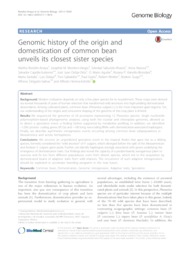Genomic history of the origin and domestication of common bean unveils its closest sister species.
Genomic history of the origin and domestication of common bean unveils its closest sister species.
Author(s): RENDÓN-ANAYA, M.; MONTERO-VARGAS, J. M.; SABURIDO-ALVAREZ, S.; VLASOVA, A.; CAPELLA-GUTIERREZ, S.; ORDAZ-ORTIZ, J. J.; AGUILAR, O. M.; VIANELLO, R. P.; SANTALLA, M.; DELAYE, L.; GABALDÓN, T.; GEPTS, P.; WINKLER, R.; GUIGÓ, R.; DELGADO-SALINAS, A.; HERRERA-ESTRELLA, A.
Summary: Background: Modern civilization depends on only a few plant species for its nourishment. These crops were derived via several thousands of years of human selection that transformed wild ancestors into high-yielding domesticated descendants. Among cultivated plants, common bean (Phaseolus vulgaris L.) is the most important grain legume. Yet, our understanding of the origins and concurrent shaping of the genome of this crop plant is limited. Results: We sequenced the genomes of 29 accessions representing 12 Phaseolus species. Single nucleotide polymorphism-based phylogenomic analyses, using both the nuclear and chloroplast genomes, allowed us to detect a speciation event, a finding further supported by metabolite profiling. In addition, we identified ~1200 protein coding genes (PCGs) and ~100 long non-coding RNAs with domestication-associated haplotypes. Finally, we describe asymmetric introgression events occurring among common bean subpopulations in Mesoamerica and across hemispheres. Conclusions: We uncover an unpredicted speciation event in the tropical Andes that gave rise to a sibling species, formerly considered the ?wild ancestor? of P. vulgaris, which diverged before the split of the Mesoamerican and Andean P. vulgaris gene pools. Further, we identify haplotypes strongly associated with genes underlying the emergence of domestication traits. Our findings also reveal the capacity of a predominantly autogamous plant to outcross and fix loci from different populations, even from distant species, which led to the acquisition by domesticated beans of adaptive traits from wild relatives. The occurrence of such adaptive introgressions should be exploited to accelerate breeding programs in the near future.
Publication year: 2017
Types of publication: Journal article
Unit: Embrapa Rice & Beans
Observation
Some of Embrapa's publications are published as ePub files. To read them, use or download one of the following free software options to your computer or mobile device. Android: Google Play Books; IOS: iBooks; Windows and Linux: Calibre.
Access other publications
Access the Agricultural Research Database (BDPA) to consult Embrapa's full library collection and records.
Visit Embrapa Bookstore to purchase books and other publications sold by Embrapa.

